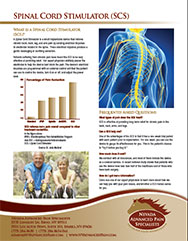Spinal Cord Stimulator
Spinal cord stimulation (SCS) is a procedure that uses an electrical current to treat chronic pain. A small pulse generator, implanted in the back, sends electrical pulses to the spinal cord. These pulses interfere with the nerve impulses that make you feel pain. They prevent pain signals from being received by the brain.
Trial Implantation
Implanting the Spinal Cord Stimulator is typically done using a local anesthetic and a sedative at our comfortable office in Reno, NV. Your doctor usually will first insert a trial stimulator through the skin (percutaneously) to give the treatment a trial run. (A percutaneous stimulator tends to move from its original location, so it is considered temporary.) If the trial is successful, your doctor can implant a more permanent stimulator. The stimulator itself is implanted under the skin of the belly (abdomen), and the small coated wires (leads) are inserted under the skin to the point where they are inserted into the spinal canal. The leads are inserted through an epidural needle or through a small incision into the space surrounding the spinal cord, called the epidural space. This placement in the abdomen is a more stable, effective location.
Find the Right Location
Electrodes at the end of the lead produce electrical pulses that stimulate the nerves, blocking pain signals. The patient gives feedback to help the physician determine where to place the spinal cord stimulators to best block the patient’s pain. The lead is connected to an external trial stimulator, which will be used for approximately one week to determine if SCS will help the patient.
Determine Effectiveness
The trial typically lasts around seven days. If the patient and physician determine that the amount of pain relief is acceptable, the system may be permanently implanted. At the end of the trial implantation, the lead is removed.
Permanent Implantation
The permanent spinal cord stimulator implantation may be performed while the patient is under sedation or general anesthesia. First, one or more permanent leads are inserted through an epidural needle or small incision into the predetermined location in the epidural space.
Battery Implantation
Next, a small incision is created, and the implantable pulse generator (IPG) battery is positioned beneath the skin. It is most often implanted in the buttocks or abdomen. The lead is then connected to the IPG battery.
End of Procedure
The implant’s electrical pulses are programmed with an external control unit. The patient can use the external control unit to turn the system on or off, adjust the stimulation power level and switch between different programs. After this outpatient procedure is complete, you and your doctor determine the best pulse strength. You are then told how to use the stimulator at home. A typical schedule for spinal cord stimulation is to use it for 1 or 2 hours, 3 or 4 times a day.
KTVN Channel 2 – Reno Tahoe News Weather, Video –
Brochure for download
Nevada Advanced Pain Specialists is recognized as an industry leader in pain management. We have a state-of-the-art facility in Reno, Nevada, that allows for us to offer the highest possible level of quality care of our patients.
We are committed to providing a comprehensive and multi-disciplinary approach for each individual’s pain complaints to provide the most appropriate care. Our approach includes analysis of biomechanics, joint motion, as well as skeletal, nerve and muscle tissues. Every individual is evaluated for the root cause of their pain – not just a “quick fix” approach to only provide symptomatic relief.
Your pain will be evaluated with latest diagnostic tools and technologies used by the professionals at Nevada Advanced Pain Specialists to make accurate assessments including: EMG/Nerve testing, MRIs, x-rays, bone scans, and diagnostic pain injections.

